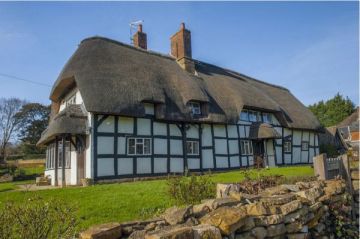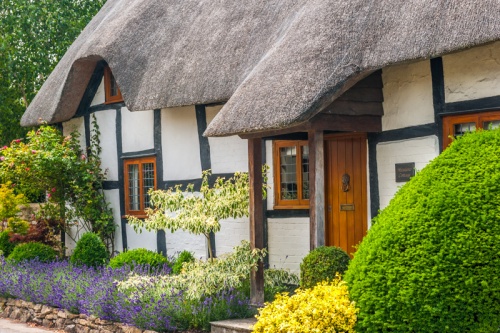
The pretty Worcestershire village of Little Comberton lies at the northern foot of Bredon Hill, a few miles south of Pershore. The village is reached only by minor roads, which help give it a secluded, timeless air. That aura of great age is enhanced by the large number of picturesque timber-framed and thatched cottages, many of them dating to the 16th century and before.
There are 22 listed buildings in Little Comberton. All are rated at Grade II except for the parish church of St Peter, listed as Grade II* by English Heritage. One picturesque thatched cottage, known for obvious reasons as Old Thatch, has been the subject of a jigsaw puzzle.
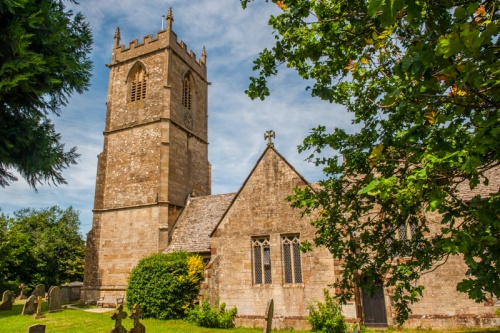
St Peter's Church
The church is thought to stand on the site of a Roman temple, and numerous Roman artefacts have turned up in the area. The oldest part of the present building is 12th century. There are vestiges of Norman stonework in the chancel wall, but the most interesting Norman feature is a peculiar tympanum over the north door, carved with the shape of a cross surrounded by peculiar raised whorls.
Inside, there are several 12th-century single lancet windows, one of which displays traces of early wall paintings. Set into the chancel floor are well-preserved medieval floor tiles, and there are several fragments of medieval stained glass in the windows.
Pause in the 17th-century church porch to examine the stone benches. They are carved with the outlines of hands, said to be those of newly-married brides.
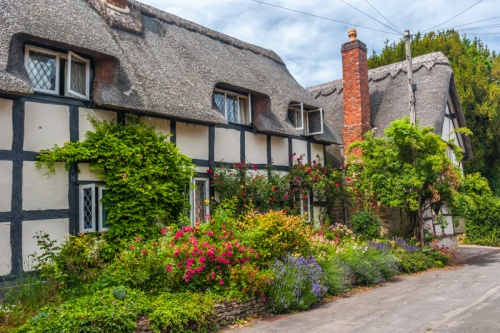
History
The earliest recorded history of Little Comberton occurs in the Domesday Book of 1086, where the church is said to belong to the monks of Westminster (now Westminster Abbey). Most of the land was leased to Gilbert Fitz Thorold, with a smaller portion held by a man known only as Urso.
We can't be completely certain about the Domesday entry, for it only lists Comberton, presumably combining the two villages of Great and Little Comberton into one.
After the Dissolution of the Monasteries under Henry VIII, the manor of Little Comberton was granted to the powerful Duke of Northumberland and from him, it passed to the Savage family of neighbouring Elmley Castle. The Savages eventually sold the lordship, and at present, there is no Lord of the manor.
Henry VIII's links to village extend beyond simply selling the manor; his sixth wife, Catherine Parr, once owned The Old Manor and Nash's Farm. The Manor we see today has been substantially rebuilt, but in its grounds is a Grade II listed 17th-century dovecote. Nash's farm boasts another 17th-century dovecote. Curiously, the former is a rectangular building while the latter is circular.
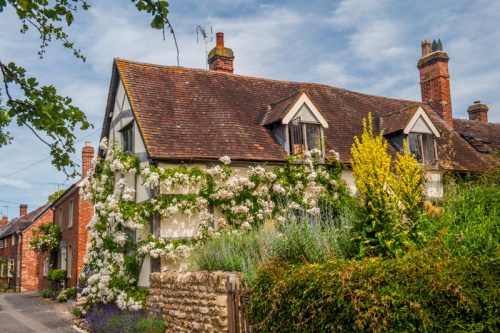
The excellent village guidebook reminds us that the area around Pershore was at the centre of conflict during the Civil War, and both the Royalists and the Parliamentarians demanded taxes of the local population. There is no record that the villagers paid any mind to either demand!
Whilst the village has some lovely timber-framed cottages, it also has a large number of Victorian houses. Many of these were built under the influence of Rev. William Parker, who served as the Rector of Little Comberton for over 50 years, beginning in 1826.
Rev. Parker was responsible for the village school, which now serves as the village hall. The school was built in a corner of the churchyard, but in 1897 it was taken apart and reassembled on its current site on Pershore Road.
On the north-east side of the nearby crossroads stands the War Memorial, erected in 1919. Unlike many such memorials, it lists the names of all those from the parish who served in WWI, not simply those who made the ultimate sacrifice, with the names of the three servicemen who lost their lives being gilded to stand out.
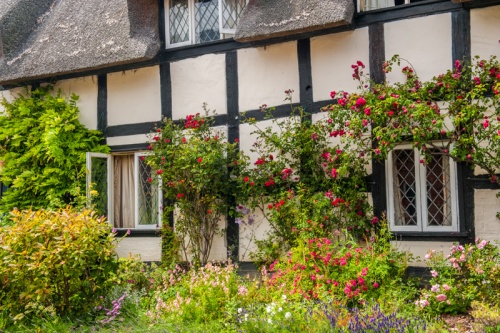
Further north on the lane leading to neighbouring Wick stands Lantern Cottage, a thatched 17th-century building thought to once have housed nuns. When repairs were carried out in the second half of the 20th-century, two skeletons of adult women were found, both with crosses around their necks. With the women were the skeletons of two infants. This certainly suggests that two of the nuns died in childbirth or shortly after.
Roughly opposite Lantern Cottage is a drive leading to Oldhouse Farm, thought to have originally served as a residence for monks. It seems logical to presume that the monks were responsible for the nuns' pregnancy, but the truth of the story is unknown.
On Wick Road is The Forge, a brick building that once served as the village smithy.
A study of the 1851 census for Little Comberton is fascinating; the occupations listed for residents is like an encyclopedia of bygone crafts. Here there were two blacksmiths, a hurdle maker, a shepherd, a laundress, a bonesetter, a midwife, and three women whose occupation was listed as gloveress (a maker of kid gloves).
Getting There
Little Comberton is a delightful rural village, full of old world charm. It is reached from Pershore via the B404 and Goodleigh Hill, or by a lane from Elmley Castle.
My thanks to the excellent guidebook, Little Comberton: A View of a Country Village by David Parker, for many of the historical details in this article.
About Little Comberton
Address: Pershore Road,
Little Comberton,
Worcestershire,
England
Attraction Type: Village
Location: On minor roads 2 miles south of Pershore.
Website: Little Comberton
Location map
OS: SO966429
Photo Credit: David Ross and Britain Express
HERITAGE
 We've 'tagged' this attraction information to help you find related historic attractions and learn more about major time periods mentioned.
We've 'tagged' this attraction information to help you find related historic attractions and learn more about major time periods mentioned.
Find other attractions tagged with:
NEARBY HISTORIC ATTRACTIONS
Heritage Rated from 1- 5 (low to exceptional) on historic interest
Little Comberton, St Peter's Church - 0.1 miles (Historic Church) ![]()
Elmley Castle, St Mary's Church - 1.6 miles (Historic Church) ![]()
Pershore Abbey - 2 miles (Historic Church) ![]()
Strensham, St John's Church - 3.7 miles (Historic Church) ![]()
Ashton-under-Hill, St Barbara's Church - 3.8 miles (Historic Church) ![]()
Almonry Heritage Centre Museum - 4.3 miles (Museum) ![]()
Evesham, All Saints Church - 4.4 miles (Historic Church) ![]()
Evesham, St Lawrence's Church - 4.4 miles (Historic Church) ![]()
Nearest Holiday Cottages to Little Comberton:
Elmley Castle, Worcestershire
Sleeps: 2
Stay from: £287 - 1078
More self catering near Little Comberton



